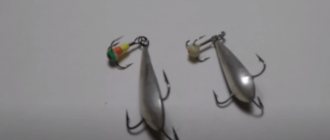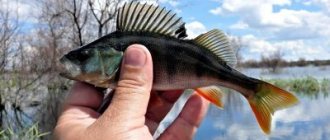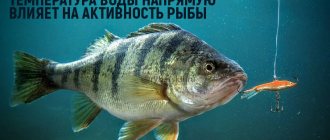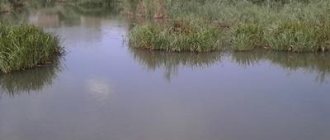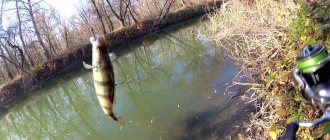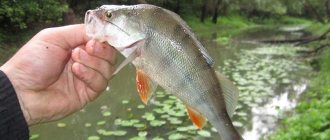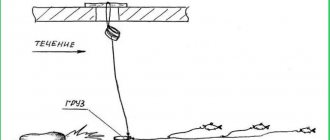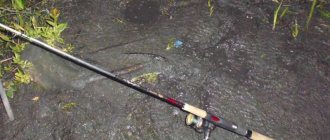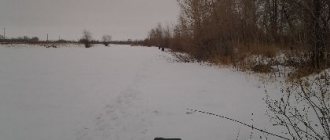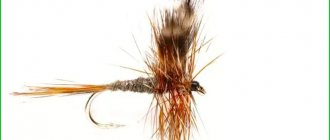Catching perch in winter with a jig.
It’s hard to seduce an inactive perch, and what’s more, you also have to find it. If you don’t know where exactly he is, then this sluggish fish needs to be forced to react to your bait.
This is precisely the essence of the search when catching perch in winter in the wilderness.
What you need to use to catch perch:
JORMYSHKA
There are no options here, the jig will be a priority. Moreover, jigs are predominantly of a minimum size (maximum - medium). The tones should not be bright: brown, dark green, black... Unlike early winter fishing, advice on which you will find in the article “Perch Fishing in Winter - First Ice” , here acid colors work quite rarely. And with a large size, you may not even see a single bite.
The movement of the jig should be smooth: barely, barely swing with a very smooth rise up.
If during the first ice I personally make a maximum of three postings, then in the middle of winter with such tactics, I left the reservoir empty. At the same time, people who like to “fly agaric” or who simply have nerves of iron can sit on a hole and make 20 entries on it. And on the twenty-first retrieve, catch a perch. They were catching fish!
And thanks to these observations, I came to the conclusion that in the dead of winter you need to fish every hole for a long time.
This should be done especially if you are sure that there is a perch here. Or you even noticed a minor glitch in the game. This is when you can see from the nod that the perch did not bite, but simply touched or passed by and thereby disrupted the play of the jig. In late winter, you even need to pay attention to this! If you find such a place and these incomprehensible actions occur, then let the hole settle and after some time come back and try again. Try to change the frequency of the game, it is possible that the perch will become active.
Perch fishing in winter, especially in the middle of nowhere, is divided into certain periods of activity. You may not see any results all day, but in just 20 to 40 minutes, something makes him start to react. And it is precisely for this reason that during the day you need to find a perch site using the beacons described a little earlier. Conclusion:
We check the holes for quite a long time and note even the most insignificant activity in them.
Equipment for fishing in the wilderness
In many ways, the outcome of catching perch in January or February from ice depends on the strength and durability of the gear used and its compliance with extreme conditions. The use of braided cord in this case is not entirely justified; it is more effective to use high-quality monofilament. This version of the thread benefits from resistance to negative temperatures and a high degree of elasticity. To catch a striped predator, a fishing line with a diameter of 0.8-0.14 mm is sufficient.
For winter, it is ideal to use a metal nod rather than a plastic one. Thanks to the nod, the angler can make the bait game more interesting and varied.
It is better to take a thin rod, given the small size of the perch. The tool must bend and be sufficiently elastic. For comfortable and quick interaction with gear, the fishing rod is equipped with a reel.
Bloodworm.
Also, in the middle of nowhere, when fishing with a jig, feeding the holes with bloodworms often helps. You know that there is a perch in this place, you found it, it reacted somehow. Throw in the bloodworms and let the holes “settle.” Make the holes at a small distance from each other. The fish is not active and moves very reluctantly. Can be done literally at a distance of one meter. After you have fed the hole, you can fish not only with a jig with bloodworms, but also with a naked jig without bait.
And the most interesting thing that sometimes happens in the middle of nowhere is when a large perch does not react to anything, but at the same time bites on a micro jig with a bloodworm, on a “stand”! This is such incomprehensible nonsense! But in fact, I myself have repeatedly encountered this situation. You run around like crazy all day, tried everything, while your grandfather sits next to you and catches you. He put the fishing rod down, then nodded twice, put it down again... A few minutes later he had a smooth bend and a one-kilogram perch. Of course, this is not a pattern, but catching perch in winter is not a predictable activity, often bringing unexpected surprises.
Fishing technique
Using small baits in fishing, they resort to standard game methods. For example, you can slowly lower the bait to the bottom, tear it off the bottom and lower it again. When it touches the bottom, a cloud of turbidity forms, which attracts striped fish.
Another way to play is to slowly raise the bait to the maximum height that your hand can reach. This method of play uses pauses. Often the predator bites at the highest point or during a pause.
If the fish is in the upper layers of the water, then it can be provoked by a smoothly falling bait. If the striped fish stays near the bottom, then it is better to play the game there, just a couple of centimeters away, without touching the ground. Oscillations are made very light, using long pauses.
On a jig with a nozzle
For the dry winter period, a simple jig is often used. It can come in different forms:
The main condition is that this jig should be small from 3 mm. The colors used range from light and bright to matte black. The big advantage of the jig is that it can be used together with fresh bloodworms. With its movements on the hook, it will additionally attract perch.
Small-weight jigs can be safely used in places where fishing with balancers and spinners is simply impossible.
On a rewindless
During the deep winter, with little perch activity, fishing with a baitless jig is more effective than a spinner or a balancer. The fact is that when the perch is inactive, it is easier to tempt it with a small bait. With the right game, it is quite possible to provoke a low-active predator to bite.
It’s not bad at this time to catch perch on the bulldozer, tapping the bait on the bottom and raising the turbidity. The striped fish has long been known for its curiosity, which probably spurs it to try a daring bait.
To the balancer
A balancer is a small artificial bait that imitates a whitebait. It is painted in bright colors, which further tempts the perch. It is equipped with hooks, single on the side of the head and tail, under the belly - triple or single.
A set of such artificial baits of different colors can help you find the key to a half-asleep fish. The bait is played at the very bottom, making sharp rises and letting the bait touch the bottom. This way you can imitate a feeding fry. You can fish simultaneously in different layers of water.
For the spinner
Copper, aluminum, and stainless steel are used as manufacturing materials. The inactivity of the striped fish also affects the size of the bait for fishing - they should not be large. The shape of the spoon is made to resemble a fry. Gliding bait is used in shallow water. The Gvozdik spinner is better controlled at great depths of 4m. The tees on spinners are loosely attached through a ring or two rings, which allows you to hook the fish more strongly.
Conclusion
Catching perch during this difficult period is not easy, but it is quite possible. The main thing is to find a place for him to stay, since he moves reluctantly. It is important to choose the right bait, fishing technique and not miss the bite. Not everything, of course, depends on the fisherman. The weather can make its own adjustments, forcing the fish not to bite at all. However, the pickiness of fish during this period of the year can be an additional incentive and excitement to catch it.
Catching perch in winter using a balance beam.
BALANCER FOR PERCH
Often, winter fishing professionals, or those who simply love it very much, use a balancer in the deep winter. Personally, I have very rarely had good results with the balancer. But this is solely my opinion and I am in no way going to dissuade anyone from this method of fishing.
Remember that on absolutely any fishing there is always room for experimentation.
Winter fishing rod equipment
The fishing rod itself should not be long and heavy. The basic rule is that the handle should fit comfortably in the palm of your hand. This will allow you to transmit slightly noticeable vibrations to your hand during weak bites.
Particular attention should be paid to the installation of the nod. With sluggish and careful prodding, he should be sensitive. The average nod length for perch is from 5 to 8 cm. When catching large croakers, the alarm should be more elastic. This will help avoid line breakage when hooking a test specimen.
But you also need to take the purchase of fishing line seriously. To avoid annoying breaks, it must stretch well and at the same time be thin. The best diameter is from 0.08 to 0.1 mm.
Bait selection
In winter, perch are caught using a balance beam, a jig or a spoon. All three baits are designed for vertical lift.
Balance
This is an artificial fish with bright colors and is the size of a food fry. Standard - silver body, red tail, contrasting eyes and fins. Manufacturers take into account the fact that predators attack from different sides. In the standard version, the perch bait is equipped with built-in hooks, as well as an underbelly tee. The tail part is made of plastic, metal, silicone, fur.
On ice, it is advisable to take a set of baits of different colors, from natural to poisonous. Often, during wiring, a previously unused balancer may unexpectedly work.
The tackle is kept parallel to the bottom, simulating feeding fish. When lowered during pauses, the balancer sways like a real fry. With this bait it is convenient to fish several horizons at once, taking long pauses between them.
Mormyshka
In the wilderness, when catching perch, a small tungsten jig of round (pellet-shaped), oval, cone-shaped or other shape with a diameter of 3 to 10 mm is often used. The bait is effective with a weight of 0.2 to 0.5 grams. Colors vary from shiny light to matte black.
A huge advantage of jigs is that their ultra-small size and weight allow you to successfully catch perch in places where a spoon or balancer does not work.
Jigs are usually used as baitless bait. To enhance the bite, use: bloodworms, burdock moths, maggots, multi-colored cambrics or small beads.
Popular among deep-winter fishing enthusiasts are:
Winter spinner
The tackle is made from different metals: copper, brass, aluminum, stainless steel. The size of the spoon should not be too large, since the striped fish, saving strength, does not always strive to swallow large prey.
The shape resembles a fry. “Carnations” and “gliders” are very popular. “Nail baits” are convenient to work at depths from 4 to 9 m. Thanks to the petals, the gliding bait copes well in shallow water.
For high-quality hooking, tees are attached to one or more rings. There are models with hard soldering of one tip or a double tip.
Sometimes the perch gets caught in the lure with its gills or body when it rises sharply. This is a good sign even in the absence of active biting - there are a lot of fish in this place, you just need to choose the right wiring.
Where to look for perch in the wilderness.
If the ice has been standing for a long time, and besides, it is also covered with snow, the situation with oxygen in the water is not important. In this case, you need to focus not so much on the relief as on the influx of fresh water. These are the mouths of streams, rivers, the confluence of any canals, even gullies. In winter, quite often there are large gullies in places where the current exits and the ground begins. It is behind these gullies that perch is often most active in winter.
And he comes there because the oxygen regime there is much better.
Since perch fishing in winter, in the wilderness, is divided into short periods of time, it is important to monitor the activity of the current. Now the water level in rivers and reservoirs is controlled. And therefore it is necessary to “catch” this first push when, as they say, “the first wave” occurs. It is this first pressure that lifts the food supply from the bottom, which significantly increases the activity of the fish. Then the bites occur literally one after another, although this process lasts several tens of minutes. Then the water continues to flow, but there is no longer a bite.
Accordingly, if you are in the right place at the right time, you are with the fish. If you were in a different place - “That means there is pressure today!”
So, it doesn’t hurt to fish not only the upper edges of the current, but also the lower ones! This is exactly the place where the drop ends and the flat bottom begins. There is no point in fishing the dump itself; after all, during the current, the perch does not hang somewhere on the steep slopes themselves.
Remember that often fishing for perch in winter will be successful either on the upper edge or on the lower edge! And it is they who need to be caught during the first “push” of the water.
Search for fish
Perch behaves very typically for freshwater fish, striving for places that are warm and saturated with oxygen. Perches often spend the winter at a great distance from the shore at elevations above the bottom. Another favorite wintering place for striped fish is underwater springs or confluences of streams and rivers.
On a note! In this case, you should avoid places with a heavily silted bottom and where there are large accumulations of last year’s vegetation. The rotting process greatly reduces the amount of oxygen in the water, which is already scarce under the ice. In small bodies of water, fish even die from lack of oxygen. That’s why the fish stays in areas where there is an influx of fresh, oxygen-filled water. It is found on the upper and lower edges, along the edges of sand spits and wherever there are some irregularities in the bottom.
At the reservoir
In stagnant and low-flow water, as ice thickness increases, fish activity decreases. The striped one becomes passive and may completely refuse to peck. Due to the lethargy of the fish, it is worth increasing the pauses during fishing or playing. Perch saves energy, so it is unlikely to react to the rapid movement of the bait.
Perch stays in holes and near other bottom irregularities. Also, on reservoirs, it can approach the shore if the bottom there is flat or covered with concrete slabs.
On the river
Oxygen greatly increases the activity of the striped fish, so in places with fast currents it responds to bait much more readily. The predator moves after the fry and it is worth looking for it in places where small fish accumulate. Having found such accumulations, you can also find perch.
Rules for winter fishing for perch using a jig
Unfortunately, even experienced fishing enthusiasts may believe that tactics in this difficult but fascinating task are not so necessary and important. They believe that perch bites absolutely anywhere and on absolutely any bait. This opinion is erroneous, since it can lead to the fact that all the efforts made during fishing will be in vain and without results.
Of course, perch lives throughout the entire territory of a river or other body of water, but its accumulation, as a rule, is quite uneven. That is why there are places where you can’t catch a perch at all, no matter how hard you try, but there are places that can be confidently called fishy.
Every adult and every fisherman, no matter with or without experience, understands that in every business there must be a clear plan that is useful to follow. Fishing in this sense is no exception, because the key to excellent fishing is, first of all, correct and consistent tactics.
In order for jig fishing to be as effective as possible, and for fishing to bring you real pleasure, you need to follow a number of principles:
- First, you need to understand in what place and how deep the perch is hiding.
- It is equally important to try to determine exactly which particular game of the jig at the moment will attract the predator more: moderate or active.
- You definitely need to record how many fish you managed to pull out of the hole before the perch stopped biting and left that place.
- If the perch is not very deep (no more than 4 meters), and you have the opportunity to feed it with bloodworms, you should pay attention to how the fish reacts to complementary feeding, how often it appears in your field of vision.
- In such conditions, it is important to use a fishing rod with the correct fishing line thickness and jig size at the right time.
Perhaps the sequence of actions described above will frighten those fishing enthusiasts who are accustomed to ease and simplicity in this matter, and also do not want to strain themselves further. But you shouldn’t be scared, because the process of hunting perch with a jig is not as complicated as it might seem at first glance. However, if you approach this matter thoughtfully and seriously, the result will not be long in coming.
In conditions of winter ice fishing, the most correct tactics lead to identifying the largest number of perches actively catching the bait, and then adapting to other conditions. Some may think that there is little pleasant and interesting in such fishing, in fact, it will captivate you, like a game of chance. And if you consider that everything will take place in beautiful winter nature and fresh frosty air, you are guaranteed a lot of positive emotions!
Efficient postings
When the activity of the fish is weak, great success is achieved by those who attract the predator solely by playing with bait. The first stage is attracting attention. If a predator stands a few meters away, the tackle will be noticed. At the second stage, a school of perch gathers. Then the fish's hunting instinct turns on, even if it is not hungry.
The main method of fishing with a jig is to lower the tackle to the bottom and raise it by 5-10 cm with short amplitude movements. Vibrations are created by frequent pushes of the index finger on the whip. When it hits the bottom, the bait raises a light cloud. This is quite enough to attract the attention of a predator and start active biting.
The next method is a slow, oscillatory raising of the bait up to 1.5-2 m, with short pauses of 3 to 5 seconds. The hand movement should be smooth and rhythmic, which is achieved through constant training. With this method, the perch can bite both during a pause and at the highest point of the rise. Often the striper will grab the bait as it drops.
A method of fishing at low temperatures, when sluggish fish are concentrated closer to the bottom - the jig is lowered along with additional bait (for example, a bunch of bloodworms) and after long pauses, on average from 5 to 8 seconds, a short retrieve is made.
When fishing with a balancer, jerking movements are often used. After the bait is smoothly lowered to the bottom, a sharp rise is made from 20 to 50 cm. The perch grabs the prey during a pause.
The recommended bait for the lure is a small jerk with a long pause.
When casting on a balance beam or a spinner, it is important not to forget some features of the fish - being a predator, perch has good eyesight. The striped one quickly reacts to bright objects located just above it. If the fish is standing right at the bottom, it is better to stop the bait at a distance of 5 to 20 cm from it.
